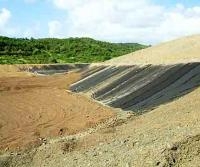Tires that protect the subsoil
Submitted on 20 July 2006 - 4:23pm
This article is reproduced by CienciaPR with permission from the original source.

By Patricia Rivera Meléndez / privera@elnuevodia.com
endi.com
Will it be possible that discarded tires can protect the atmosphere?
After a life of potholes, blows and highways, discarded rubbers have the potential to become the material that would protect our subsoils of the liquids that form in sanitary fillings.
Those tires could become another piece of trash within our garbage dumps, but not in Toa Alta and Humacao. In the sanitary fillings of these municipalities, tires are reused to be turned into a protective coating that avoids that lixiviates reach the soil and contaminate our water bodies.
Federal regulations require that before throwing garbage into sanitary fillings, a membrane of several sand layers and grave is placed to stop the garbage lixiviates from reaching the subsoil.
Since 2001, Rubber Recycling and Manufacturing (REMA) granulates near 10,000 tires daily that after getting rid of metal and other materials, provide drainage to the sanitary fillings and replace the sand and grave used for those intentions.
On this way, discarded tires not only become an useful material to the garbage dumps, but reduce the use of terrestrial crust material that, when being extracted from mountains, causes erosion.
“Instead of mixing these tires with the garbage, its possible to used them as a drainage cover in new facilities. The membrane is placed at heart of the garbage dumps to avoid that lixiviates, which are the liquids leached from the garbage, drip through the soil land and reach aquifers and other water bodies”, explained the president of REMA, Edgardo Velazquez.
“That stone from a quarry that I used before to protect the ground, can be saved for other intentions, like construction”, added the engineer.
Velazquez maintained that during the process, the rubber, the metal and the nylon that the tires contain separates. The rubber and the metal are recycled. Although also the nylon could be recycled, REMA discards it, because according to what they indicated, in Puerto Rico does not exist a recycling market for that material.
It has been estimated that, after 2010, near half of the 31 active garbage dumps in Puerto Rico will reach their life utility and will have to stop operations. The development of recycling technologies that reduce the congestion of our garbage dumps could extend the life of the sanitary fillings.
In addition to the technology of tire granulation to be used in sanitary fillings, REMA processes discarded tires that are used as aggregates for civil engineering projects of like roads, slopes and sound barriers. Also, the tires granulated by REMA serve like raw material for blocks and parking barriers. Also, they have designed the grounds and game areas of recreational parks.
At the moment, REMA is lobbying so that the Highways and Transportation Authority accedes to use the rubber as aggregate for asphalt. According to Velazquez, the use of the rubber in asphalt could extend the life of our streets, which would be a saving for the Government who, daily, stuff the interminable potholes that adorn our highways.
For two years, they have been a collaboration agreement with the University of Puerto Rico in Mayagüez (RUM) to research on new uses for the recycled rubber. One of the most important findings confirmed the rubber’s capacity of removing polluting agents like lead, organic solvents and copper from the water.







